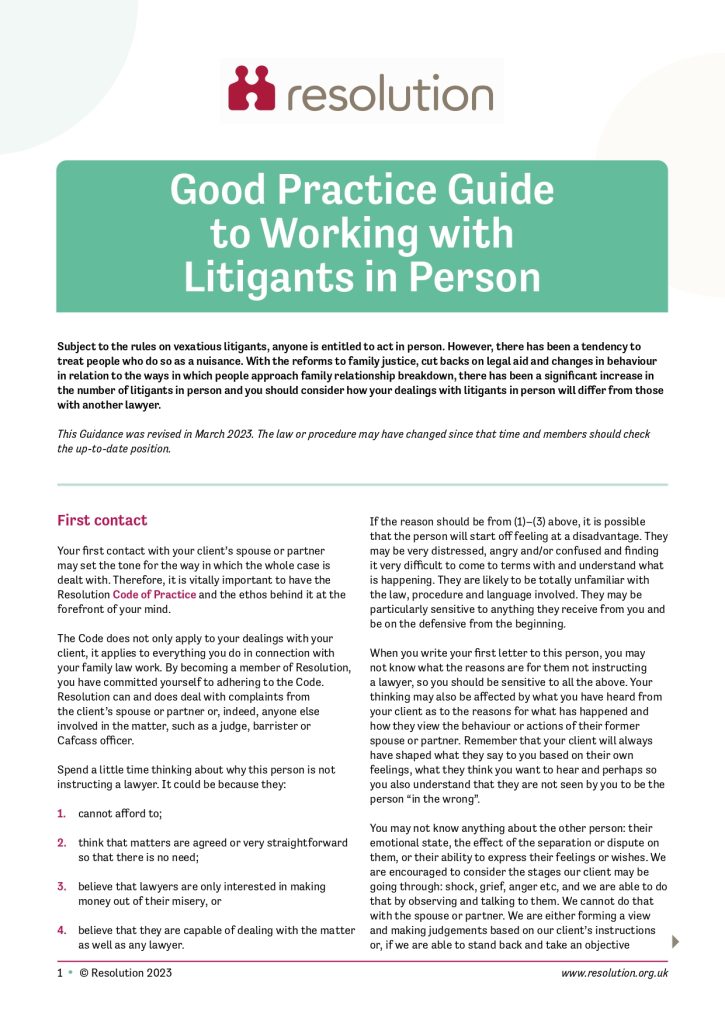Litigants in person – post-LASPO
With the number of self-represented parties sky-rocketing, it is important that lawyers tailor their approach when working with them
“I hate lawyers. I just work for them.”
Erin Brokovitch (2000)
 I wonder if this is how litigants in person feel about us? We’ve all no doubt had experience with working with LiPs, in some capacity, and sometimes it’s as if those of us “in the know” use this title when discussing them, and we say it with a deep sigh/rolled eyes. They are people who have chosen to represent themselves, or who cannot afford to pay for lawyers’ fees and have no choice but to show up and face the wrath of one of us on the other side.
I wonder if this is how litigants in person feel about us? We’ve all no doubt had experience with working with LiPs, in some capacity, and sometimes it’s as if those of us “in the know” use this title when discussing them, and we say it with a deep sigh/rolled eyes. They are people who have chosen to represent themselves, or who cannot afford to pay for lawyers’ fees and have no choice but to show up and face the wrath of one of us on the other side.
The National Audit Office (NAO) found that the reduced sources of funding as a result of LASPO led to a 22% increase in cases involving children and a 30% increase in all family law cases in which neither party had legal representation. To highlight the impact of LASPO following its implementation in 2013, by the period between January and March 2014, 80% of all family court cases included at least one party who did not have legal representation (ACSO, 28 January 2022).
Fast forward to 2021, and the Family Court Statistics Quarterly recorded that:
- in private law cases with at least one hearing the proportion of parties with legal representation stood at 59% in 2012 compared to 31% in July-September 2021
- in July to September 2021, the proportion of disposals where neither the applicant nor respondent had legal representation was 37% (an increase in 23% since Jan-March 2013). Correspondingly, the proportion of disposals where both parties had legal representation went from 41% in January-March 2013 to 19% in July-September 2021
The MoJ has said previously (in its Research Summary 2011) that reliable data on the impact on courts of more LiPs is difficult to measure. Perhaps more importantly from my perspective, is their comment that it may be impossible to know whether the intended savings in legal aid reform are being offset by expenditure for LiPs elsewhere. By elsewhere, I take that to mean the court system in its entirety.
The fact is, LiPs are here to stay, so let’s learn to work with them.
Challenges, motivations and backgrounds of LiPs
The MoJ’s research summary on LiPs provides interesting insight into who they are, the issues they face, and their motivations. Research suggests they are more likely to have a lower income and lower educational level, and were likely to be younger. Men were more likely to be unrepresented than women and were usually the respondents in proceedings.
On a snapshot of my cases, I’m not sure I agree with the “lower educational level”, nor the age part, though yes, they are mainly men. It also depends on the type of case: there are more LiPs in financial remedies cases where there are no children.
A colleague said this, when I asked for his thoughts: “‘Tesco bag nightmare’ because they so often have a stack of papers in a bag-for-life. And they will always try to produce documents at random times from it (in FR cases mainly).”
In Children Act work, the LiP often has a varied background: professional woman; men/women on lower incomes or on benefits; young men.
Motivations, says the MoJ in its 2011 Research Summary, tend to be to do with lack of funding but also because some deem their case “simple enough to handle on their own (whether this was the case or not)”. Others felt that lawyers were not the best placed to advance their interests. Make of that latter reason what you will.
Impact
The impact of unrepresented parties is felt on the entire court system, right from the security guards, to the ushers/clerks and to the judiciary. Court staff have felt they must tread a fine line between giving appropriate assistance and giving legal advice. Some studies noted that LiPs presented a challenge to the judiciary in maintaining impartiality – they were concerned about the perception of bias where one party was represented and the other was not. (See studies in the MoJ Research Summary by Moorhead and Sefton, 2005; Dewar et al, 2000; and Goldschmidt et al, 1998).
And then, there is the impact on us, on the lawyer on the other side, where we often feel we need to do additional work to compensate for the lack of a lawyer opponent.
What do we do and how should we do it?
My suggested top tips:
Do make contact prior to court
It really does help – them and you – in the long run. Or to look at this the other way around, as a colleague of mine puts it: “Being a LiP means you have to be your own solicitor … you have to be able to get to the right people, and obtain responses.”
Do approach them when outside the courtroom
Introduce yourself and consider whether any documents have been prepared that you can mutually exchange.
The line between giving information and giving advice can be a fine one
If you decide to do more than say hello, stick to factual, generic information: explain the court process for that hearing, explain who can be in court.
In court …
I have found all judges/magistrates to be incredibly helpful so, chances are, the procedure will be explained by your tribunal
Bundles … gosh … bundles
It is going to be our side that prepares them, for now at least. Try and ensure you raise the following in court, perhaps by way of suggesting a recital and/or an explanation by the tribunal:
- LiPs must respond to comments on the index
- LiPs must provide position statements/witness statements/exhibits etc because there is no “hiding” or “springing the other side by surprise” in family court proceedings. They must do this, and they must do it within the timelines set out
Recently I was on a remote hearing on an FDA and I suggested to the judge that, given the amount of assistance out there for bundle preparation and, given that my client was privately paying, the applicant might be ordered to prepare the bundle himself. The judge refused, saying that by the time my instructing solicitor had liaised with the applicant directly, my client’s costs would likely substantially increase, so it was easier, quicker and more economical for us to prepare the bundle.
That said, when LiPs are required to prepare bundles, Resolution’s LiP Committee are almost there with finalising guidance and it will be available to all via the Resolution website.
Witness statement preparation
I always include the witness statement templates that is provided within the SFO (as laid out by Justice Peel):
Basic witness templates can be found at:
The Resolution LiP Committee has just produced new witness statement guidance.
Orders
You will be drafting them, so make a note to self to ensure you cover the following before your tribunal rises:
- Are you directed to send it to the LiP for agreement? If the LiP asks for the order to be sent to them, ensure that there is a date by which they must respond, failing which you will simply send the draft to court.
- Dates for filing/serving – these must be complied with.
- Who is going to prepare the bundle? Again, ensure dates by which they must respond to index contents, etc, are clearly set out.
- Who is going to liaise with the LiP – obtain current contact details.
General guidance
I’ve had situations where LiPs take full advantage of their position, playing naïve in court and then ignoring communications – and actually become quite arrogant with it all, because they feel that they can do no wrong. Keep all communications in writing and keep it firm and polite.
I share an anecdote on a related topic. A few weeks ago I represented a lady who had previously been a LiP. She had been communicating regularly, duly responding to letters and providing information. It turned out that she had used an AI facility to write her emails. Whilst there was nothing wrong with the content and form, it was felt by the court that she should refrain from doing this, given the potential for confidential information to be accessed by third parties. An example of someone trying to do the right thing – by using the right language, etc – and getting it wrong.
Signposting
There are a number of organisations and websites that you can signpost to:
- advicenow.org.uk/content/going-court-or-tribunal-without-help-lawyer
- citizensadvice.org.uk/law-and-courts/legal-system/going-to-court-without-a-solicitor-or-barrister/
- supportthroughcourt.org/
Finally, there is of course the Resolution website itself, which has useful articles and good practice guidance documents. Point the LiP in the direction of the website, with a signpost to the section titled “Representing yourself in court as a litigant in person” where you will find:
- a glossary of legal terms that will help LiPs understand and navigate their way through what might be unfamiliar or confusing processes.
- Top tips for representing yourself in court as a litigant in person
- What to expect? – a guide to the stages of the divorce process depending on whether applying individually or as a couple.
- Application for a Divorce
- Child Arrangement Orders
- Financial Orders
- Guidance for litigants in person on remote hearings in the Family Court
- Guidance for litigants in person on preparing a witness statement
I leave you with another comment from a colleague which I feel sums up the issues:
“LIPs in my experience are often difficult to deal with due to often feeling overwhelmed, understandably, by the whole experience of having to represent themselves in court. I sympathise with them and believe they are significantly disadvantaged as a result, however most sensible tribunals will afford them the necessary grace and ensure that they are able to make all the representations they require.”
 Resolution’s Good Practice Guide to Working with Litigants in Person for members covers:
Resolution’s Good Practice Guide to Working with Litigants in Person for members covers:
- First contact
- Communications
- Steps relating to the divorce application or other proceedings
- Domestic abuse
- Service of proceedings
- Children disputes
- Agreements and consent orders
- Contact at court
- Harassment
- Dealing with lay advisers
- Practice Direction 27A
- The Child Arrangements Programme
- The Children and Families Act 2014
It can be accessed on the Resolution website alongside an extensive range of other Good Practice Guides.